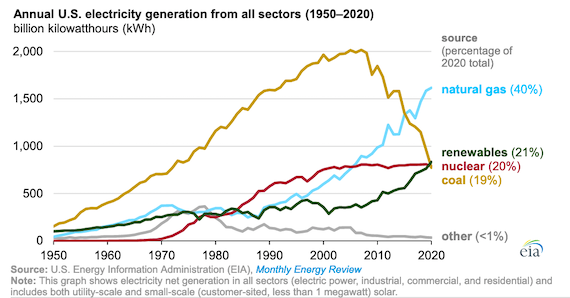Ann Arbor (Informed Comment) – The Energy Information Administration, the primary authority in the federal government on energy numbers, concludes that renewables, primarily hydro, wind and solar, rose to become 21% of electricity generation in the US in 2020.
This is the first time on record that renewables were the second-largest generator of electricity in the U.S.
Renewables overall increased 9% between 2019 and 2020. About half of US clean energy now comes from solar and wind, and the other half from hydroelectric power.
Wind generation increased by 14%.
Solar rocketed up even more, with utility-scale solar projects of 1 megawatt or more growing by 26%.
Small-scale solar such as rooftop installations like the one we have increased by 19%.
The Clean Power Association says that America put in 26 gigawatts of renewables electricity plants in 2020 — 80% more than in 2019 — bringing total US renewables capacity to 170 gigawatts.
In the US, some 78% of all new electricity generation was from wind and solar, which are clearly the future of the American grid.
American renewables beat out coal, now only 19%, and nuclear, at 20%. Coal is dirty and expensive, and coal power plants have been replaced in droves by wind farms and by natural gas. It was the largest generator of electricity in the US until 2016, and has gone into a tailspin because renewables and natural gas are much cheaper.
Natural gas, which is only half as carbon intensive as coal, is now the leading generator of electricity in the US, at some 40%.
Coal electricity generation fell 20% from 2019 to 2020.
Between renewables and nuclear, 41% of American electricity generation is now low-carbon or no-carbon.
While the increase clean gigawattage is impressive in American terms, China added 136 gigawatts of new renewables capacity in 2020, dwarfing the US effort. This massive lead that China has in wind and solar translates into advantages in manufacturing, distribution and sales of equipment like solar panels. The US, for all that it is finally making some strides, is going way too slow if it wants to be a leader in these industries and if it wants to do its part to keep global heating below an extra 3.6 degrees F.



 © 2025 All Rights Reserved
© 2025 All Rights Reserved